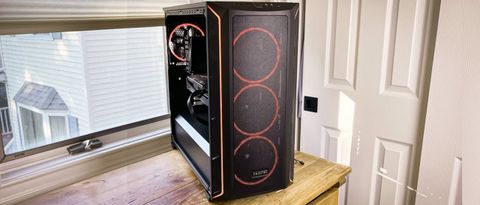Tom's Hardware Verdict
While it’s pricier than most midtowers, the Be Quiet Shadow Base 800 FX is an excellent case option for builders looking for great airflow, RGB, and quiet computing.
Pros
- +
Offers a lot for the price
- +
Respectable IO
- +
Four included RGB Light Wings fans
- +
Rotatable PCIe bracket
- +
Sound-dampening foam
Cons
- -
Visual design looks a bit plain
- -
PCIe riser cable not included
Why you can trust Tom's Hardware
In the PC building realm, German company be quiet! (henceforth referred to as Be Quiet) has a reputation for quiet cooling that’s perhaps only surpassed by its Austrian neighbor, Noctua. But Noctua has stuck mostly to the realm of fans and air coolers (if you don’t count the hoodies and keycaps), while Be Quiet also sells other products you might like to… be quiet, like power supplies, liquid coolers, and cases.
Be Quiet’s latest case, the Shadow Base 800 FX, features an abundance of RGB, excellent airflow, and some sound-dampening foam for $220. If you don’t care about lighting, the company also offers a non-FX model that drops the included fan count down from four to three, which sells for $170. Neither model is near the affordable end of the mid-tower case spectrum. But as we’ll see in testing, both the thermal and acoustic performance of the Shadow Base 800 FX are excellent, making it a strong contender for a spot on our Best PC Cases list.
| Type | ATX Mid-Tower |
| Motherboard Support | Mini-ITX, Micro-ATX, ATX, EATX |
| Dimensions (HxWxD) | 21.6 x 9.7 x 19.8 inches |
| Max GPU Length | 16.9 inches |
| CPU Cooler Height | 7.1 inches |
| External Bays | X |
| Internal Bays | 4x 2.5 inch 2x 2.5 and 2x 3.5 inch |
| Expansion Slots | 7 |
| Front I/O | HD Audio (mic+audio) LED Control 1x USB 3.2 Gen 2 Type-C 2x USB 3.2 |
| Other | GPU Bracket |
| Front Fans | 3x 140mm |
| Rear Fans | 1x 140mm |
| Top Fans | X |
| Side Fans | X |
| Bottom Fans | x |
| Weight | 30 pounds |
| Warranty | 3 years |
Features of the Be Quiet Shadow Base 800 FX
The Shadow Base 800 FX is an airflow-focused mid-tower, which sounds weird given the company’s name and the fact that most airflow cases are at least a little noisy. But the company didn’t forget its origins, as it includes a sheet of sound-dampening foam on the rear side panel to keep things quiet.

Design-wise, the Shadow Base 800 FX looks pretty standard – offering a filtered mesh front panel with two columns of RGB lighting. It doesn’t look bad; it just doesn’t particularly stand out. But I was much more impressed by the 800 FX’s performance and what’s included in the box. The case comes with four 140mm Light Wings fans, which are 4-pin, giving you the ability to easily adjust the speed and aRGB.
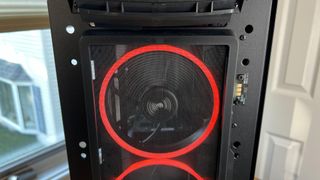
While this is a mid-tower, Be Quiet isn’t holding back on cooling support: 420mm worth of radiators or fans can be placed at the front of the case or at the top. The rear of the case can house a single fan, either 120 or 140mm.
Despite the Shadow Base 800 FX not following the recent trend of adding side fans, this chassis does have fan cut-outs at the bottom. You’ll just have to remove the hard drive cage to add fans there.
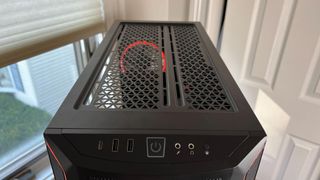
The Be Quiet Shadow Base 800 FX has the ability to hold four 2.5-inch SSDs or two 3.5-inch mechanical drives. The placement of the drives is fairly standard: behind the motherboard tray and/or in the hard drive cage. I was a bit surprised to see that this case can hold 3.5-inch hard drives behind the motherboard tray, given the fact that there is a sheet of foam on the rear side panel. But that may help deaden mechanical drive noise.
The case’s IO is also standard: You get one USB 3.2 Type-C port and two USB Type-A 3.2. I’d love to see more here, but most motherboards don’t have more than one USB-C front-panel header anyway. There are also two audio jacks and an RGB control button here, to the right of the power switch.

Internal Layout of the Be Quiet Shadow Base 800 FX
The Be Quiet Shadow Base 800 FX stands at 21.6 inches tall and is 9.7 inches wide and 19.8 inches deep. Again, these are fairly typical mid-tower dimensions. Big CPU coolers, like the company’s very own Dark Rock Pro 4, will fit in this case. Coolers up to 180mm (7.01 inches) and GPUs up to 430mm (16.93 inches) are supported.
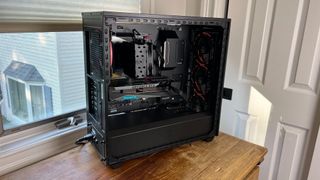
When I was installing our hardware into the Shadow Base 800 FX, my eyebrow rose when I saw the cable management bar. It looks shocking like those found in an NZXT case – which certainly isn’t a bad thing.
Graphics cards can be installed intwo ways in this chassis: the traditional orientation, or vertically. The Shadow Base 800 doesn’t come with a riser cable, but the PCIe bracket can be rotated, which is nicet. I was slightly annoyed that a riser cable wasn’t included, but you can get one on Amazon for $20-$50, with PCIe 4 cables landing near the high end of that spectrum.
Testing Hardware
Our testing hardware is based on Intel’s 12 Gen “Alder Lake” platform, specifically a Core i7-12700KF, which is cooled by a Noctua U12s air cooler. Our graphics card is a Gigabyte RTX 3070 Ti Gaming OC.
Acoustic Results for the Be Quiet Shadow Base 800 FX
Our acoustic tests consist of three scenarios: We run the CPU at full load, the CPU and GPU at full load, and an optimized mode. The CPU full load test runs the CPU and case fans at their maximum speed. For the CPU and GPU full load acoustic test, we also stress the Gigabyte RTX 3070 Ti Gaming OC and set the fans at 75% speed, because in gaming the fans never run at 100 percent and are far too loud when they do.
For the optimized mode, we run the GPU fan speed at 30% and run the CPU and included case fans at the lowest speed that they will spin.
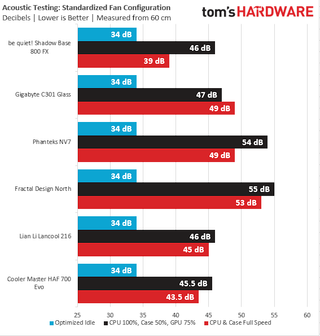
The Shadow Base 800 FX certainly lives up to its company’s name. During our acoustic testing, the case stayed dead-silent when I ran the case and CPU cooler at full speed. When I added the GPU into the mix, the noise level went up a significant amount, but sound levels were still quite reasonable. These results show how well Be Quiet Engineers its fans and how much a sheet of sound-dampening foam can help.
Thermal Results for the Be Quiet Shadow Base 800 FX
For the thermal tests, all case and CPU fan speeds are set to 100%. The Core i7-12700K is set at a fixed 4.7GHz clock at 1.3v on all performance cores to ensure consistent power consumption across test scenarios. Letting the GPU run at 75% fan speed enables it to maintain its power target while sticking to one set, reasonable fan speed so that the temperature is the only variable.
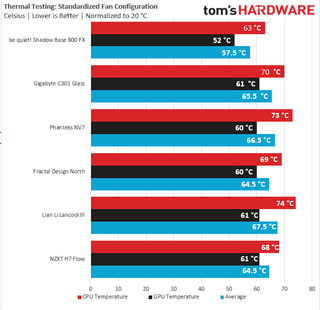
The Shadow Base 800 FX is nearly as thermally impressive in our tests as it was with noise levels. Sure, these results are somewhat expected given the case comes with four fans. But Lian Li’s Lancool III also comes with four 140mm fans, and its numbers were roughly 10 degrees warmer in our test.
Bottom Line
Be Quiet’s Shadow Base 800 FX is much more than your average RGB-sporting mid-tower, even though it may look like one at first glance. The case may not turn heads based on its looks alone, but it’s one of the best-performing thermal and acoustic cases we have tested. At $220, it’s fairly expesnive, especially for a mid-tower. But its stellar performance and inclusion of four aRGB fans make it worth the investment.
MORE: Best PC Cases
MORE: Best Mini-ITX Cases

Myles Goldman is a freelance writer for Tom's Hardware US. He reviews keyboards and cases.
-
JohnBonhamsGhost i loved their Dark Base 700, $180 for that one.Reply
very quiet design and pretty modular, but really could've used a mesh top option.
Silent Base 802, $180 for that one.
one of the best cases i've ever worked with and many options not regularly available with a lot of high-end cases.
and $220 for this one?
don't really see much that makes it worth another $40.
even $180 for the previous ones was a bit too much. -
Dr3ams I've been using Bequiet! products for over ten years. Even though they're not perfect, I prefer the quality and funtions over their competition.Reply -
WrongRookie I still think Lian Li 216 is better.Reply
At 100$ you get two 160mm argb fans, one 140mm fan at the back and an option to change the front io panel at the side.
Pretty much all features are there compared to this and it's at a very competitive price. -
watzupken Barring the fans used, there is really very differentiating factors between such an expensive casing, vs a cheap mesh case. So not sure if it worth paying so much for it. After all, you can get better or comparable fans out there.Reply -
JohnBonhamsGhost Replywatzupken said:you can get better or comparable fans out there.
since this article is specifically about be quiet!,Dr3ams said:Examples?
they even offer better fans than what's included;
the Silent Wings Pro 4 are quite a bit better overall than the included Light Wings. -
RodroX I own a Pure Base 500DX, and I had and worked with lots of "generic" and not "generic" cases, the main issues I found with the branded ones like mine is how time consuming it is to build a PC.Reply
You have to deal with lots of compartments for differente parts, screw thing in very uncomfortable positions/places and do all this OCD cable management to achieve and amazing ~2° C less compared to cases that lack cable management features. Im not saying is ok to fix everything in it, close the panel and be done with it, but some people take it too far, like its a beauty contest.
Last week I had a few issues with my main PC, so I took my living room one, which is a really small matx case, with only 1x80mmm fan at the back and no compartments.
I had a hard time making my Corsair RM750x to fit inside but it did, I was also able to fit my RTX 2070 in it, added 1 120mm fan at the front and another SSD. I finally changed the humble Athlon 3000G with my R5 3600 with the boxed cooler (no way to fit my 120mmm tower in this case).
At first I thought "this thing is going to set on fire", to my surprise it didn't. To be fair this case was not designed for a huge PSU and GPU, so the fact that I could put them inside, its really amazing.
CPU temps were more or less really close to the ones inside the bequiet one with the tower cooler, GPU temps while benchmarking were a little higher, but to be fair there was only about 12mm top between the GPU fans and the bottom of the case, gaming temps were normal. I bet if my motherboard (Asrock A320M-HDV) had the only PCIE slot higher in the PCB (like most mobos do) temps will be better. Yes the 80mm fan was annoyingly noise, but it was better than having no PC at all.
I guess the main things to be aware when picking a case should be: 1. What kind of parts are you going to use (not the same the to build and have to acoommodate a low-end system than a high-end one), 2. to not fall for the shiny RGB concept, 3. to look for cases that avoid putting solid panels behind or in front of fans. -
helper800 The Be Quiet case outperformed the others in the comparison by so much I question if the testing methodologies were consistent across all the tests for each case. That does not necessarily matter as long as the test results for each case are replicable, but it can paint an outlier as being "better" than the others if the testing is not consistently the same across all the cases tested.Reply
